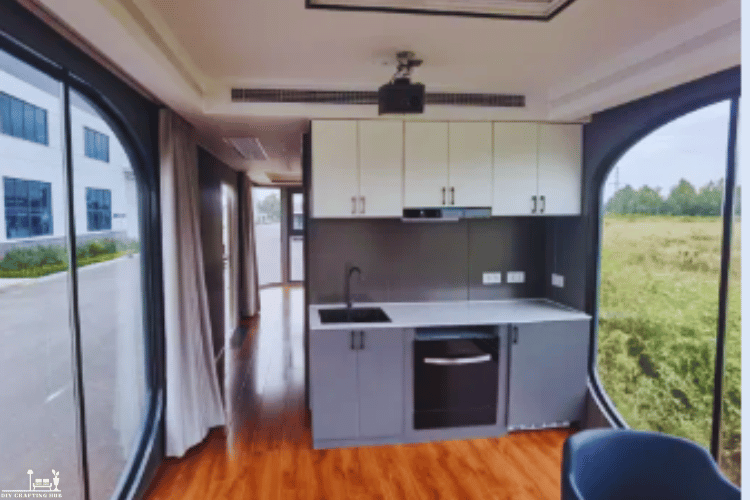In the realm of contemporary architecture and sustainable living, the concept of a capsule house has garnered significant attention. Initially envisioned as compact, minimalist dwellings suitable for urban environments and eco-conscious individuals, capsule homes have evolved over the years, incorporating innovative improvements to meet the demands of contemporary living. In this blog, we explore 10 innovative improvements that have transformed capsule home design, making them more efficient, comfortable, and adaptable to the needs of modern residents.
What is a Capsule house?
A capsule home, also known as a micro-home or tiny home, is a compact and minimalist living space designed to maximize efficiency and functionality within a small footprint. Typically ranging from a few hundred to a few square feet in size. The capsule homes feature innovative design solutions to optimize space utilization and accommodate essential living needs.
They often feature modular furniture, multifunctional fixtures, and smart technology to create versatile living environments. Popular among those seeking affordable housing, minimalist lifestyles, or environmentally sustainable living options, capsule homes offer a simple yet stylish alternative to traditional modern housing.
1. Capsule Housing Smart Integration of Technology
Innovative mini-houses represent a pioneering approach that harnesses cutting-edge technology to augment convenience and efficiency in residential living. These dwellings integrate state-of-the-art smart home systems, empowering residents to remotely manage a multitude of aspects within their living spaces. From regulating temperature and lighting to ensuring security and entertainment preferences, these systems offer unprecedented control and customization.
By seamlessly integrating IoT (Internet of Things) devices, such as sensors and actuators, automation becomes a cornerstone, optimizing daily routines and enhancing sustainability by intelligently managing energy consumption. Through this harmonious fusion of advanced technology and compact living, these homes redefine modern living standards, offering a harmonious blend of comfort, convenience, and environmental consciousness.
2. Pod Dwelling Modular Design for Flexibility
At the core of the evolution of mini homes is modularity, a principle that revolutionizes living spaces. By leveraging modular design, these dwellings offer unparalleled flexibility, enabling residents to tailor and transform their habitat as needs evolve. Key to this adaptability is modular components like walls, furniture, and storage units, ingeniously engineered for effortless reconfiguration.
This dynamic approach optimizes space utilization and seamlessly accommodates various lifestyle preferences. Whether expanding for a growing family or simplifying for minimalist living, the simplicity and ease of modularity empower inhabitants to sculpt their environment to exacting specifications. It’s a paradigm shift where customization meets simplicity, redefining the way we conceive and inhabit living spaces in a world where adaptability is essential.
3. Micro Home Sustainable Materials and Construction
As sustainability becomes the centre of architectural discourse, micro-living units have embraced eco-friendly materials and construction practices. From recycled steel and bamboo to low-impact composites. Moreover, modern capsule homes prioritize sustainability without compromising structural integrity or aesthetic appeal. Energy-efficient insulation, passive solar design, and rainwater harvesting further reduced environmental impact while reducing operating costs.
4. Space-Saving Furniture Solutions for Capsule House
Discover ingenious space-saving furniture solutions tailored for compact residences. These innovations maximize functionality without compromising style. From multifunctional sofa beds to foldable dining tables, each piece is meticulously designed to optimize every inch of your living space. With sleek designs and smart engineering, these furniture solutions seamlessly blend form and function.
So, providing versatile options for modern living. Whether you’re creating a cosy reading nook or a compact home office, these space-saving solutions cater to your needs. Embrace simplicity without sacrificing comfort with furniture that adapts to your lifestyle. So, transform your compact residence into a haven of efficiency and style.
5. Vertical Expansion for Urban Housing Contexts
In densely populated urban areas, land scarcity calls for creative housing solutions. Vertical expansion offers a viable alternative, allowing capsule cottages to stack vertically without compromising structural integrity. Vertical gardens, rooftop terraces, and interconnected sky bridges enhance outdoor living space while minimizing ground footprint. Moreover, capsule cottages are an appealing option for urban dwellers seeking sustainable urban living solutions.

6. Tiny House Off-Grid Capabilities for Self-Sufficiency
With growing concerns about resource depletion and climate change, off-grid capabilities have become a defining feature of modern capsule homes. Solar panels, wind turbines, and rainwater collection systems enable residents to generate their electricity and water, reducing reliance on centralized utilities and fostering self-sufficiency. Off-grid living not only promotes environmental stewardship but also enhances resilience against external disruptions.
7. Biophilic Portable Shelter Design for Health and Well-Being
Incorporating elements of nature into built environments has been shown to improve mental and physical well-being. Biophilic design principles, such as natural lighting, indoor greenery, and organic materials. They are increasingly integrated into nano house architecture to enhance occupants’ connection to the natural world. Living walls, skylights, and indoor gardens create tranquil retreats that promote relaxation and rejuvenation amidst the hustle and bustle of modern life.
8. Flexible Outdoor Capsule House Spaces for Recreation
Despite their compact size, modern small houses prioritize outdoor living experiences, offering flexible outdoor spaces for recreation and relaxation. Rooftop decks, balcony gardens, and communal courtyards provide residents with opportunities to commune with nature. Moreover, socialize with neighbours and engage in outdoor activities such as gardening, yoga, and al fresco dining. By blurring the boundaries between indoor and outdoor spaces. Furthermore, capsule communities foster a sense of community and connection to the environment.
9. Passive Cozy Cabin Design Strategies for Climate Adaptation
Climate change poses significant challenges to the built environment, necessitating adaptive design strategies to mitigate its impacts. Passive design techniques, such as orientation, shading, and natural ventilation, are integral to modern capsule dynasty architecture, ensuring thermal comfort and energy efficiency across diverse climatic conditions. High-performance glazing, thermal mass, and green roofs further enhance thermal performance while reducing reliance on mechanical heating and cooling systems.
10. Collaborative Petite Co-Housing Models
Recognizing the importance of social interaction and shared resources, modern microhouses often embrace collaborative co-housing models that promote community living and resource sharing. Co-living spaces, communal kitchens, and shared amenities encourage collaboration. So, fostering a sense of belonging and mutual support among residents. By pooling resources and sharing responsibilities, co-housing communities exemplify the principles of sustainability, affordability, and social equity.
Are Kitchens a Standard Feature in Capsule Houses?
Kitchens are standard features in small houses, albeit in compact forms customised to the limited space. These kitchenettes are ingeniously designed to maximize functionality while minimizing footprint. They often include essential appliances such as a small refrigerator, a microwave or compact stove, and storage cabinets.
Some designs may incorporate innovative solutions like fold-out countertops or modular elements to optimize space usage further. Despite their smaller size compared to traditional kitchens. So, mini-house kitchens are fully functional, allowing residents to prepare meals comfortably within the confines of their compact living quarters.

Conclusion: Modern Capsule House Design Trends
From the integration of smart technology to sustainable materials and collaborative co-housing models, the evolution of capsule homes embodies the convergence of innovation, sustainability, and human-centred design. By embracing these 10 innovative improvements, modern small houses present a compelling vision for the future of urban living.
Where compactness, efficiency, and community converge to create harmonious and resilient built environments. As we continue to address the challenges of urbanization, climate change, and resource scarcity. Moreover, the evolution of capsule homes serves as a beacon of hope, illustrating that creative design and mindful living can coalesce to create a more sustainable and enriching lifestyle.
FAQs
How much are capsule houses?
The cost of a capsule home can vary widely depending on various factors such as:
- Size: Larger nano households will typically cost more than smaller ones.
- Materials: The choice of materials used in construction can significantly impact the cost.
- Location: Prices may vary depending on the region, local building codes, and land prices.
- Features: Additional features such as smart technology integration, off-grid capabilities, and sustainable features may increase the cost.
- Customization: Customized designs or special requirements may incur extra expenses.
As a rough estimate, capsule homes can range from a few thousand dollars for DIY or prefabricated models to several hundred thousand dollars or more for custom-built, luxury options. It’s best to research specific manufacturers and models to get a more accurate idea of the cost based on your preferences and requirements.
How many rooms does a capsule house have?
A capsule home typically features one main living area that serves multiple functions, including sleeping, dining, and living. However, depending on the design, it may also include a compact bathroom and a kitchenette. These spaces are ingeniously integrated within the compact footprint to maximize efficiency.
In which country are capsule homes popular?
Capsule homes are particularly popular in densely populated urban areas, with Japan being a notable example. In Japanese cities like Tokyo and Osaka, where space is limited, capsule hotels and micro-apartments offer affordable and compact living solutions. However, the concept has also gained traction in other countries facing similar urbanization challenges, such as Singapore and Hong Kong.








